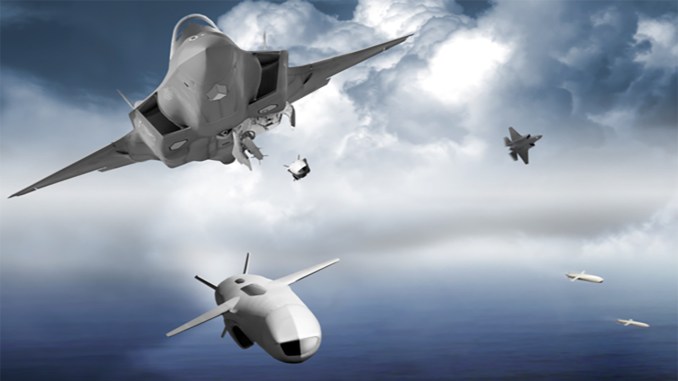
F-35A Expands Strike Capabilities with New JSM (Joint Strike Missile) Contract.
American F-35As will soon be able to undertake long-range stand-off anti-surface strikes as the US government has signed a $141 million contract with Norway’s KDA (Kongsberg Defence & Aerospace) for acquiring the JSM (Joint Strike Missile), the DoD (Department of Defense) announced on May 31, 2024.
The “undefinitized contract action for the JSM production Lot 1, provides for all up rounds, containers, and test equipment for the JSM,” DoD said. “Work will be performed in Kongsberg, Norway, and is expected to be completed by August 31, 2026.” The procurement has been categorized as a “sole source acquisition,” meaning it has been effected without tendering and competitive bidding.
“The Joint Strike Missile (JSM) is an air-launched strike missile and is designed to fit into the internal weapons bay and to fulfil complex missions, such as ASuW (Anti-Surface Warfare) and land attack. The primary targets are typically highly defended and high-value assets on sea, in coastal waters or on land,” Kongsberg says.
The JSM is the air-launched version of Kongsberh’s NSM (Naval Strike Missile). It flies at high-subsonic speeds, weights 416-kg at 4-meters long and has a range of around 275 km (150-nautical miles).
Tactical Utility
“(It) has an off-board, on-board and in-flight mission planning capability and can engage targets based on a predefined set of Rules-of-Engagement,” the company added. “The selection of JSMs by both the USAF and Royal Norwegian Air Force also fully supports NATO’s vision for interchangeability of equipment between allied nations,” a statement from the firm quoted Eirik Lie, KDA’s president. Development of the JSM was contracted by the Norwegian Defence Materiel Agency (NDMA).
This means the missile can be fed with target coordinates and information on the ground, prior to launch, sparing the pilot of the complicated target acquisition, engagement and launch sequences. It can serve to be a tactical handicap, especially against a peer adversary. This is much like the British-French Storm Shadow/SCALP-EG that has scored some battlefield successes against Russian ground targets, when launched from Ukrainian Su-24 Fencer fighter-bombers.
This also has massive utility in the predominantly maritime theater of the western Pacific before China. Here too, airborne anti-land and anti-shipping strikes would be an acute need against PLAN (People’s Liberation Army Navy) vessels and island bases in the SCS (South China Sea).
The F-35 cannot carry large missiles like the AGM-158C LRASM (Long-Range Anti-Ship Missile) and the AGM-158A JASSM (Joint Air-to-Surface Standoff Missile) inside its internal weapons bay in the underbelly. Carrying them on the external hardpoints would compromise stealth, which is unlikely to never be a priority in such a war. The LRASM is the air-launched ship-strike version of the JASSM.
The JSM version of the NSM is however compatible with the F-35’s internal weapons bay. A photo of the missile in the compartment suggests one unit can be easily carried in that section. In 2018, Kongsberg had called the project to integrate the JSM with the F-35 as the “Block-4 update.”
The JSM anti-ship missile installed in the internal compartment of the F-35A fighter. (Image credit: Kongsberg).
” data-medium-file=”https://i0.wp.com/theaviationist.com/wp-content/uploads/2024/06/JSM-1-1.jpg?fit=460%2C259&ssl=1″ data-large-file=”https://i0.wp.com/theaviationist.com/wp-content/uploads/2024/06/JSM-1-1.jpg?fit=706%2C397&ssl=1″ class=”size-large wp-image-86620″ src=”https://zephyrnet.com/wp-content/uploads/2024/06/us-to-buy-norwegian-joint-strike-missile-for-its-f-35a-stealth-aircraft-1.jpg” alt width=”706″ height=”397″ srcset=”https://zephyrnet.com/wp-content/uploads/2024/06/us-to-buy-norwegian-joint-strike-missile-for-its-f-35a-stealth-aircraft-1.jpg 706w, https://zephyrnet.com/wp-content/uploads/2024/06/us-to-buy-norwegian-joint-strike-missile-for-its-f-35a-stealth-aircraft-2.jpg 460w, https://zephyrnet.com/wp-content/uploads/2024/06/us-to-buy-norwegian-joint-strike-missile-for-its-f-35a-stealth-aircraft-3.jpg 128w, https://zephyrnet.com/wp-content/uploads/2024/06/us-to-buy-norwegian-joint-strike-missile-for-its-f-35a-stealth-aircraft-4.jpg 768w, https://zephyrnet.com/wp-content/uploads/2024/06/us-to-buy-norwegian-joint-strike-missile-for-its-f-35a-stealth-aircraft-5.jpg 678w, https://i0.wp.com/theaviationist.com/wp-content/uploads/2024/06/JSM-1-1.jpg?w=781&ssl=1 781w” sizes=”(max-width: 706px) 100vw, 706px” data-recalc-dims=”1″>
Reports said the JSM “was developed by Kongsberg as part of the JSF (Joint Strike Fighter) program” – the original project name for the F-35. “At that time, the missile was chosen as the main anti-ship weapon for F-35A/B/C fighter jets, as well as a complement to LRASM missiles for F/A-18 Super Hornet deck-based fighters.”
On Apr. 3, 2024, Lockheed Martin announced “successfully conducting a historic LRASM flight test with four missiles simultaneously in flight.” Subsequent reports said a pair of F/A-18E/F Super Hornets launched four LRASMs, which flew to the targets simultaneously. The test was representative of how these weapons might be employed in a future high-end conflict. A salvo of such missiles can also change course and alter their direction when on-board ESM (Electronic Support Measures) detect enemy AD or SAM (Surface-to-Air Missile) tracking.
Consistent with F-35’s ‘Strike Orientation’
Like the ship-borne NSM, the JSM too can be used against both ship and land-targets, making it versatile and allowing commanders significant tactical flexibility. Moreover, the F-35 itself is primarily a “strike fighter.”
It performs that role by operating as an airborne, tactical command post, trading data with other F-35s, Generation 4++ aircraft and other air and ground assets using its stealth, sensor fusion and enhanced situational awareness as its defining features.
Indeed, it is also a capable air-dominance plane with primary W/BVR (Within/Beyond Visual-Range) capability. But the JSM’s role is not only harmonious with the F-35’s core doctrinal orientation, but also consistent with the emerging defense technological needs before Russia and China. Here conventional land and surface strength of the two countries makes it difficult for Western allies to have complete air superiority.
- SEO Powered Content & PR Distribution. Get Amplified Today.
- PlatoData.Network Vertical Generative Ai. Empower Yourself. Access Here.
- PlatoAiStream. Web3 Intelligence. Knowledge Amplified. Access Here.
- PlatoESG. Carbon, CleanTech, Energy, Environment, Solar, Waste Management. Access Here.
- PlatoHealth. Biotech and Clinical Trials Intelligence. Access Here.
- Source: https://theaviationist.com/2024/06/03/us-to-buy-norwegian-jsm/




